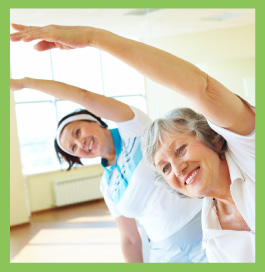
Taking Action
Inadequate exercise is an independent risk factor for a host of chronic health conditions, especially cardiovascular disease (CVD). When you increase your physical activity even a little, at any age, disease development and progression are slowed down. Ultimately, with consistent exercise, you can experience a decrease in chronic conditions by 20% to 50%.
Health experts advise that you dedicate at least 30 minutes a day to some kind of physical activity. Brisk walking on this schedule, for example, can reduce your blood pressure by 5% or more, thereby decreasing cardiovascular risk as well.
Physical Activity will:
- Improve the efficiency and decrease the workload of your heart and lungs
- Improve your HDL (good) cholesterol, LDL (bad) cholesterol, and triglyceride (fat) levels
- Lower your blood pressure and produce an immediate decrease in blood pressure that can persist for up to 22 hours
- Help you achieve and maintain a healthier body weight
- Lower your blood sugar on par with glucose-lowering medications2
- Improve your muscle tone and bone density
- Increase your stamina (energy levels)
- Boost your confidence, self-esteem, and sense of well-being
- Improve your ability to cope with stress and decrease anxiety and depression
- Lower your heart rate
- Improve sleep
- Reduce the risk for cardiovascular disease, stroke, hypertension, breast cancer, and colon cancer
- Release endorphins, the body’s natural antidepressant
- Reduce the heart attack risk for previously inactive people by 35% to 55%3
- Yield a 30% reduction in all causes of death
Beginning Exercise
Any increase in physical activity will yield a variety of health benefits. However, you must exercise on a regular basis to both achieve and maintain any real results. Keep in mind that when you stop exercising, the gains you’ve made are quickly lost, typically within a few weeks.
Strive to incorporate activities that fit into your daily life, like cycling or walking to work. The exercise routine you choose is more likely to become a part of your everyday life if it’s something you truly enjoy. Consider exercising with a friend. It can keep you motivated.
If you're thinking about walking, check out "Walk With Me", a toolkit designed by Ottawa Public Health to help you get started with your own walking group.
Follow these exercise tips to stay comfortable and safe:
Breathing:
- Breathe steadily and in a relaxed manner while you exercise
- Avoid straining yourself, and never hold your breath
Terrain:
- Walk on flat ground, initially
- If hills are unavoidable, walk more slowly when going uphill
Eating:
- It is best to wait an hour or two after a meal before you exercise because extra energy is required for digestion
Weather:
- Avoid exercising in extreme temperatures
- If it is very hot and humid, walk during the cooler part of the day, such as in the morning and later at night
- If it is extremely cold or windy, exercise indoors using stationary equipment, or walk in the hallways of your house or apartment or in a mall. If you do exercise outdoors, walk during warmer times of the day and cover your face with a scarf to help warm the air before it reaches your lungs
Posture:
- It is important that you maintain good posture. Try to keep your shoulders back and relaxed.
- Avoid slouching forward.
Stretching:
- After walking, stretch your calf muscles. They are likely to get tight as you begin to increase your daily activity.
- Stretching your entire body will help prevent injury.
Follow these tips for staying motivated:
- Choose an activity that you enjoy and that fits with your lifestyle.
- Exercise with a buddy or develop a support system with friends and family that will hold you accountable.1
- Set realistic goals or objectives you would like to achieve, and talk openly about them with important people in your life.
- Reward yourself when you have achieved your goals.
- Remember to take note of your progress. Consider the effort rather than the result.
- Keep a Physical Activity Log. This way you can see your progress and keep track of how you are feeling.
- As your fitness improves, so too will your perceived level of effort. The decreased effort you’ll feel over time is a measure of your improvement.
- Be prepared for lapses. Knowing they will happen can circumvent guilt. Simply return to your routine and keep going.
- Exercise at the same time every day — eventually it will become routine. Choosing an early start time or treating exercise like an “appointment,” prevents other commitments from getting in the way.
- Place home exercise equipment in a pleasant and easily accessible location.

